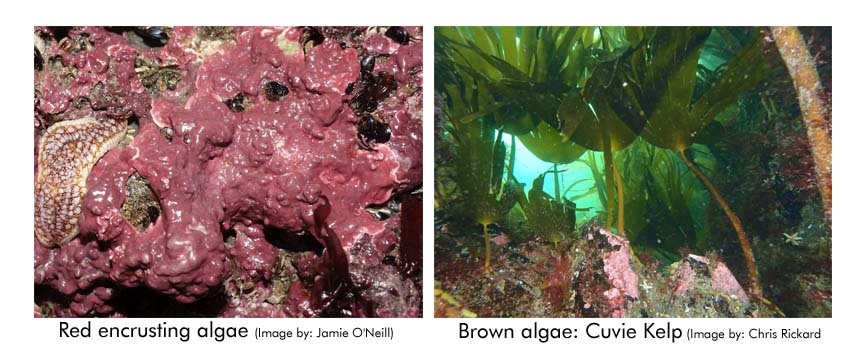Amazing Seaweeds
As the weather takes a turn we would like to draw your attention to the underdog of the intertidal zone: seaweeds. We tend to walk over them without even noticing they are there, but without seaweeds things would be very different.
Seaweeds are vital to a healthy thriving Ocean and the rocky intertidal zone; they provide food and shelter for many animals, they stabilise the sediments, protect the coast from storm damage and store carbon. They are also very nutritious and many have commercial importance in food, pharmaceutical or cosmetics industries.
Our native ocean flora are also very beautiful if you take the time to look. There are over 650 species of seaweeds around the UK to get to know and love!
Seaweeds are the largest and most complex form of marine algae, a diverse group of species which photosynthesise using chlorophyll to produce their own food but have a different body plan than plants do. They lack roots and instead have a holdfast which is used only for attachment to a hard surface. They also lack any sort of internal transport system as they exchange all the water, nutrients and gasses they need directly between their tissues and the surrounding water. They reproduce via spores that are dispersed by the ocean currents.
Seaweeds can be divided into 3 main groups depending on the dominant colour pigments found in their tissues: red, green and brown. Green seaweeds like Gut weed and Sea lettuce are often the first you will encounter along the high rocky shore, followed by brown and red seaweeds in the mid shore, and the large brown algae such as kelp dominating the low shore and beyond.


Seaweeds absorb carbon faster and produce more oxygen than trees! They are important in the fight against climate change as they represent an important carbon store as a Blue Carbon Habitat. These are marine habitats that store a proportionately higher amount of carbon than their terrestrial counterparts and even the surrounding marine areas.
UK sea temperatures have risen 2°C in the past 40 years. The ocean has also become more acidic as a result of the excess carbon it has absorbed from the atmosphere. The ocean absorbs carbon from the air – up to 50% of the excess carbon emitted since the industrial revolution! Once absorbed, the carbon reacts with the water, making it more acidic. This is called ocean acidification and it’s a by-product of climate change.
Ocean acidification makes it harder for many seaweeds to grow. Animals with shells are also being affected by this increased acidity; their shells are weakened as the acid reacts and eats away at them. This means that entire marine ecosystems and whole food webs could be altered if ocean acidification continues.
By looking at where and how seaweeds are growing we can better understand how climate change is impacting our ocean. Research suggests that cold water seaweeds are moving further north where it's cooler, while warmer water species are expanding their ranges.
You can help! Become a Citizen Scientist and complete a Big Seaweed Search. Join the fight against climate change by making swaps to reduce your carbon footprint and save energy where you can. Shop local, eat less meat, and support sustainable companies where you can. If we all do what we can our combined efforts will make a difference and get us closer to a sustainable future.
There are no items in this category.

